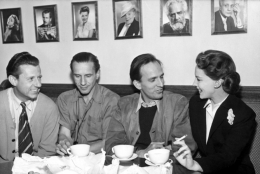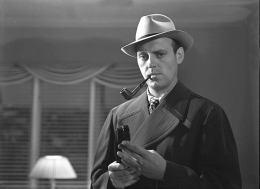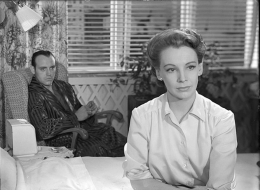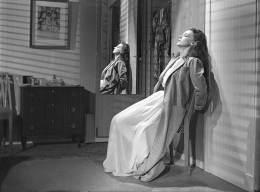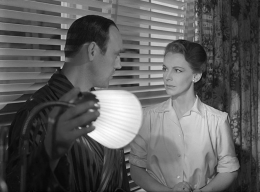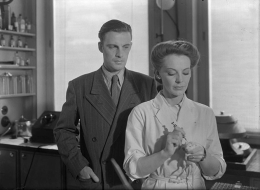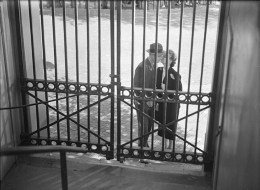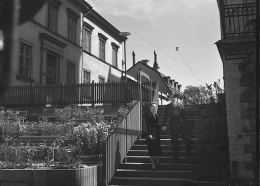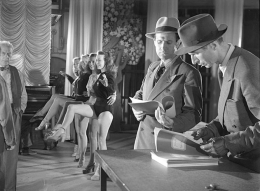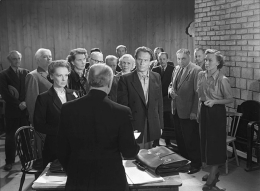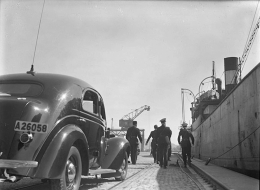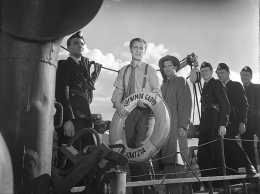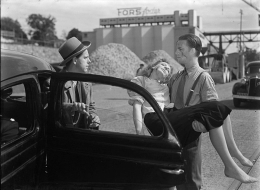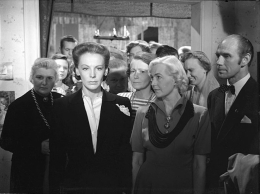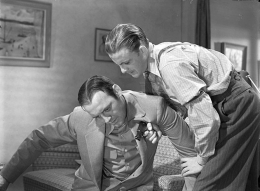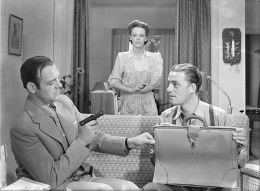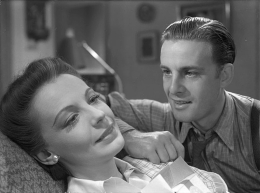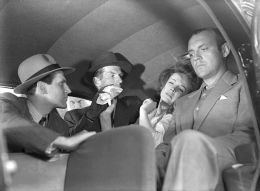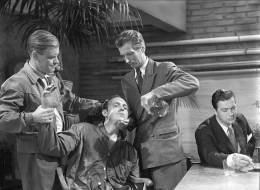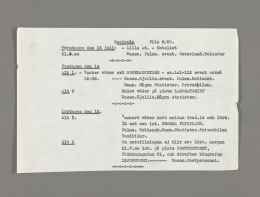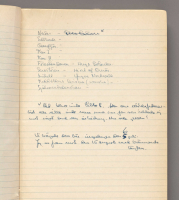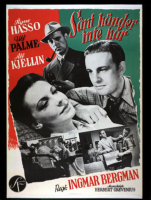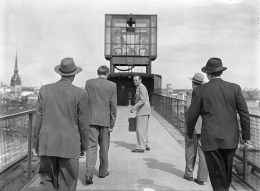High Tension
Political allegory aimed at the Soviet Union about the demonic Atkä Natas who spies on refugees in Sweden.
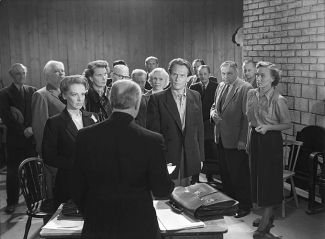
"My very soul resisted this film, hiding in the deepest darkness of my sinus and nasal passages."Ingmar Bergman
About the film
The Novel Within 12 Hours by the Norwegian writer Peter Valentin (a nom de plume of Waldemar Brøgger) was published in Stockholm in 1944 by Bonniers. Owing to the looming conflict between the Swedish government and the film industry over the entertainment tax (see also Summer Interlude), Svensk Filmindustri was keen to produce an internationally viable success in the form of a spy thriller. Herbert Grevenius was commissioned to write the screenplay, and Ingmar Bergman, 'for financial reasons', undertook the task of directing. It turned out to be a painful experience all round.
Shooting the film
Shooting began in early July 1950, directly after Bergman had completed Summer Interlude, and ended in late August. Many of the exteriors were shot in Stockholm's Södermalm district. Right from the outset the film was intended for export, which explains why an English version was produced simultaneously. Engaging Signe Hasso and Alf Kjellin to play in the film was part of the company's efforts to penetrate the Anglo-American market. Signe Hasso, who had not appeared in a Swedish film for almost a decade, lived in Hollywood yet also played a number of stage roles in England. Alf Kjellin had recently begun his career in America. In the UK the film was released early in 1953 under the title of High Tension. It went on release in Germany in 1959 under the title Menschenjagd.
Bergman in Images: My Life in Film:
I was not at all averse to making a detective story or a thriller; that was not the reason. Neither was Signe Hasso the reason. She had been hailed as an international star who Svensk Filmindustri, with incredible naiveté, hope would make the film a raging success all over the world. Therefore we filmed This can't happen here in two lenguages: Swedish and English. Signe Hasso, a talented and warm person, unfortunetly felt poorly during the entire filming. We were never sure from one day to the next whether she should be euphoric or depressed on the set. It was one difficulty, of course, but not the deciding factor.
A creative paralysis hit me after only four days of shooting. That was exactly when I met the exiled Baltic actors who were going to participate. The encounter was a chock. Suddenly I realize which film we ought to be making. Among this exiled actors I discovered such a richness of lives and experiences that the unevenly developed intrigue in This can't happen here seemed almost obscene. Before the end of the first week, I demanded to see Svensk Filmindustri's chief executive, Carl Anders Dymling, and pleaded whith him to cancel the project. But our train was running its course and could not be stopped. At about this point I had a violent attack of influenza, and from that arose sinus trouble that raged almost comically and tormented me throughout the rest of the filming. My very soul resisted this film, hiding in the deepest darkness of my sinus and nasal passages.
Few of my films do I feel ashamed of or detest for various reasons. This can't happen here was the first one; I completed it accompanied by violent inner opposition. The other is The Touch. Both mark the very bottom of me. My publishment did not fail to come from the outside as well. This can't happen here opened in the fall of 1950 and was regarded as a fiasco.
Epilogue
Most reviews of the film were negative, but a number of critics were unsure whether they should take it seriously at all. The most generous of them was 'Robin Hood', writing in Stockholms-Tidningen, who was convinced that the people behind the film were having a joke. Herbert Grevenius and Bergman were serious men, so surely they could not, in all earnestness, produce something like this? The film, he assumed, must be a satire. Yet such was not the case.
Sources
- The Ingmar Bergman Archives.
- Ingmar Bergman, Images: My Life in Film.
Distribution titles
Cela ne se produirait pas ici (France)
High Tension (Great Britain)
Menschenjagd (West Germany)
Sellaista ei tapahdu täällä (Finland)
Sådan noget hænder ikke her (Denmark)
Sånt hender ikke her (Norway)
Production details
Production country: Sweden
Swedish distributor (35 mm): Svensk Filmindustri
Laboratory: FilmTeknik AB
Production company: Svensk Filmindustri
Make up: Firma Carl M. Lundh AB
Original work: løpet av tolv timer (Novel) by Waldemar Brøgger
Aspect ratio: 1,37:1
Colour system: Black and white
Sound system: AGA-Baltic
Original length (minutes): 84
Censorship: 077.757
Date: 1950-10-18
Age limit: 15 years and over
Length: 2315 metres
Release date: 1950-10-23, Röda Kvarn, Stockholm, Sweden, 84 minutes
Filming locations
Sweden
Filmstaden, Råsunda (studio)
Biografen Lejonungen, Södermalm, Stockholm (interiors)
Stockholm (exteriors)
Music
Title: Donald Goofy
Composer: Oliver Wallace
Title: Florida Special
Composer: Dick Kolmar
Comment: (instrumental)
Title: Nele, Ay! Ay! Ay!
Composer: Armand Crabbé
Titel: Den blomstertid nu kommer
Lyrics: Israel Kolmodin (1694) Johan Olof Wallin (1819)
Britt G. Hallqvist (1979)
Title: Du gamla, du fria
Alternative title: Du gamla, du friska
Lyrics: Richard Dybeck (1844)
Title: Night in Rio
Composer: Roberto Romero
Textförfattare: Martin Kalmanoff
Title: Sjungom studentens lyckliga dag Alternatie title: Studentsång
Composer: G***** (Alias) (1851)
Lyrics: Herman Sätherberg
Collaborators
- Signe Hasso
- Alf Kjellin
- Ulf Palme
- Gösta Cederlund
- Yngve Nordwall
- Hannu Kompus
- Sylvia Tael
- Els Vaarman
- Edmar Kuus
- Helene Kuus
- Rudolf Lipp
- Segol Mann
- Willy Koblanck
- Gregor Dahlman
- Gösta Holmström
- Ivan Bousé
- Hugo Bolander
- Stig Olin
- Magnus Kesster
- Alexander Baumgarten
- Ragnar Klange
- Lillie Wästfeldt
- Hanny Schedin
- Gunwer Bergkvist
- Mona Geijer-Falkner
- Erik Forslund
- Sven-Axel "Akke" Carlsson
- Helga Brofeldt
- Georg Skarstedt
- Tor Borong
- Maud Hyttenberg
- Wera Lindby
- Mona Åstrand
- Fritjof Hellberg
- Eddy Andersson
- Harald Björling
- Sten Hansson
- Eddie Ploman
- Ingemar Jacobsson
- Wiktor "Kulörten" Andersson
- John Björling
- Nils Hultgren
- C.G. Lundin
- Peter Winner
- Gustaf Hedström
- James Harker
- Olof Sjöstrand
- Gertrud Lilienberg
- Gustaf Hiort af Ornäs
- Birger Sahlberg
- Priit Hallap
- Agnes Lepp-Kosik
- Helmi Nerep
- Hilma Nerep
- Marje Parikas
- Riina Reinik
- Harri Kaasik
- Teet Koppel
- Hans Laks
- Gustav Laupman
- Elmar Nerep
- Karl Sööder
- Nils Svenwall, Art Director
- Bengt Järnmark, First Assistant Cameraman
- Nils-Eric Carlsson, Boom Operator
- Gunnar Fischer, Director of Photography
- Alva Lundin, Titles
- Lennart Wallén, Film Editor
- Sven Hansen, Production Mixer
- Herbert Grevenius, Screenplay
- Sven Persson, Re-recording Mixer
- Herbert Stéen-Östling, Music Composer
- Erik Nordgren, Music Composer
- Eskil Eckert-Lundin, Orchestra Leader
- Helge Hagerman, Production Manager / Production Coordinator
- Sol-Britt Norlander, Script Supervisor
- Louis Huch, Still Photographer
- Ingmar Bergman, Director
